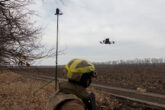November 10, 2022
Welcome to the New Age of Nukes
Nuclear weapons are back, and in a disturbingly visceral way. Vladimir Putin’s saber-rattling—“this is not a bluff” he said, warning of nuclear use in Ukraine—has sparked concern across multiple continents. The Biden administration is publicly warning that “catastrophic consequences for Russia” would follow any use of nuclear arms, and Biden himself has said that the explosion of a tactical nuclear weapon in Ukraine could end in Armageddon. Even Chinese President Xi Jinping declared that “the international community should … jointly oppose the use or threats to use nuclear weapons,” despite China’s “no limits” partnership with Russia. The world’s most destructive weapons are suddenly back on the minds of the world’s most powerful leaders.
It was not supposed to be this way. A little more than a decade ago, President Barack Obama articulated an expansive vision of a nuclear-free world. His administration’s Nuclear Security Summits, held from 2010 to 2016, aimed to increase the security of nuclear materials and decrease the chances of their use, by governments or terrorist organizations. His successor Donald Trump pursued an expansion of U.S. nuclear capabilities but employed high-stakes diplomacy aimed at inducing North Korea to give up its own. In 2020, candidate Joe Biden pledged to reduce the role nuclear weapons play in the country’s national security policy, reserving them for the sole purpose of deterring a nuclear attack.
The paradox of nuclear weapons is that they work when not used: They can and do deter aggression.
Nuclear weapons never went away, of course, and have remained a critical element of national security policymaking for decades. But as Cold War-era anxieties faded from memory, so too did the fear of nuclear weapons retreat from the public mind. Today the chances of nuclear use remain low, but they are higher than before the Russian invasion, and possibly higher than at any time since the 1962 Cuban Missile Crisis. That is dangerous. The taboo against the use of nuclear weapons in combat has remained in place since 1945 for a very good reason: Their destructive power, and the potential for escalatory effects, remains unparalleled. But the return of nuclear arms as a potentially major instrument of foreign policy means that decisions made now may well shape our world for decades to come.
Read the full article from Foreign Policy.
More from CNAS
-
Defense / Transatlantic Security
When Defense Becomes Destruction: Austria-Hungary’s Mistake and Ukraine’s RiskThis article was originally posted on War on the Rocks. The southeastern Polish city of Przemyśl, with its elegant 19th century Habsburg-era train station, remains one of the ...
By Franz-Stefan Gady
-
Defense / Transatlantic Security
Ukraine’s Catch-22 MomentThis article was originally published in the Financial Times. In Joseph Heller’s wartime classic, Catch-22, the protagonist Yossarian seeks out the US army surgeon Doc Daneeka...
By Franz-Stefan Gady
-
CNAS Insights | Budgetary Own Goals Undermine “Speed and Volume”
On November 7, Secretary of Defense Pete Hegseth laid out a plan to overhaul the Department of Defense’s (DOD’s) acquisition system. Placing an emphasis on delivering new capa...
By Philip Sheers, Carlton Haelig & Stacie Pettyjohn
-
Drones: Who Is Making the New Weapons of War?
From Ukraine and Russia to Gaza and Sudan, drones have become a key weapon of war. Which companies are making them, and profiting from this rapidly expanding but controversial...
By Stacie Pettyjohn




